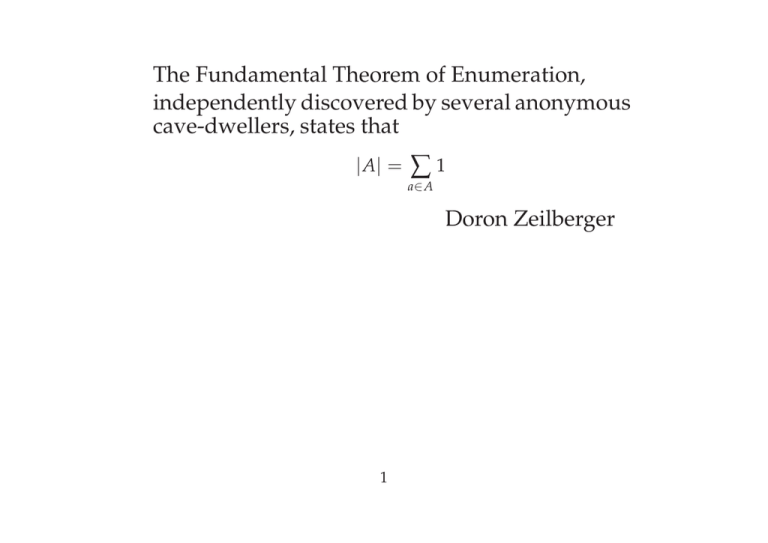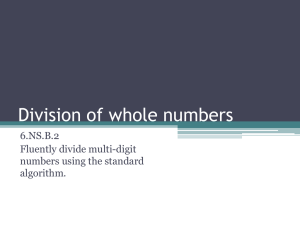The Fundamental Theorem of Enumeration, independently
advertisement

The Fundamental Theorem of Enumeration,
independently discovered by several anonymous
cave-dwellers, states that
| A| =
∑1
a∈ A
Doron Zeilberger
1
Contents
1. Introduction
2. Permutations
3. Generating Functions
4. Binomials
5. Inclusion-Exclusion
6. Möbius Inversion
7. Cauchy-Frobenius Theorem
8. Pólya-Redfield Theorem
Bibliography
2
We are interested in counting objects
But what is an answer?
Example 1. How many even numbers are there less than
n? The answer is in explicit and compact form: the integer part of n/2, i.e., [ n/2].
Example 2. How many permutations α of {1, 2, . . . , n}
are there so that α(i ) 6= i for all i.
The answer is explicit but involves a summation depending on n:
n
(−1)i
.
dn = n! ∑
i!
i =0
Sometimes explicit answers cannot be found.
3
Problem settings
Count the number of objects
• without symmetry: How many prime numbers are
there ≤ n?
• with symmetry: How many cubes are there with
green/blue faces?
4
Problem
Consider red and blue beads. Beads of the same colour
are indistinguishable.
How many necklaces are there of n beads?
The solution depends on what is considered to be a
necklace.
5
Four beads in line
2n = 16 ways to put n beads in line.
••••
••••
••••
••••
••••
••••
••••
••••
••••
••••
••••
••••
6
••••
••••
••••
••••
10 open necklaces
These can be turned over.
This means that some of the previous designs give the
same open necklace.
••••
••••
••••
••••
••••
••••
••••
••••
••••
••••
••••
••••
7
••••
••••
••••
••••
6 (closed) necklaces
These can be rotated and turned over.
••••
••••
••••
••••
••••
••••
••••
••••
••••
••••
••••
••••
8
••••
••••
••••
••••
4 patterns of necklaces
We allow change • and •.
••••
••••
••••
••••
••••
••••
••••
••••
••••
••••
••••
••••
9
••••
••••
••••
••••
Cayley 1875: Alkanes Cn H2n+2
How many isomers Cn H2n+2 are there?
Hexane and isohexane: both C6 H14 but
their structures are quite different.
Counting problems can be difficult
because of symmetries.
Rains and Sloane (1999) →
n
1
2
3
4
5
6
7
8
9
10
11
12
13
14
15
count
1
1
1
2
3
5
9
18
35
75
159
355
802
1858
4347
C8 H18
... and they have all names!
Octane
3-Methylheptane
2,2-Dimethylhexane
2,4-Dimethylhexane
3,3-Dimethylhexane
3-Ethylhexane
2,2,4-Trimethylpentane
2,3,4-Trimethylpentane
3-Ethyl-3-methylpentane
2-Methylheptane
4-Methylheptane
2,3-Dimethylhexane
2,5-Dimethylhexane
3,4-Dimethylhexane
2,2,3-Trimethylpentane
2,3,3-Trimethylpentane
3-Ethyl-2-methylpentane
2,2,3,3-Tetramethylbutane
11
Notation
• N = {0, 1, . . . }, Z, Q, R and C
• We sometimes consider the field (R, +, ·) of real
numbers, but what is needed is an arbitrary field
(sometimes of characteristic 0).
• [1, n] = {1, 2, . . . , n}.
• The Kronecker symbol:
• k | n:
δnk =
k divides n for k ∈ [1, n].
12
(
1
if n = k
0
if n 6= k
• For a finite set X, let | X | denote its size.
A set X is an n-set (n-subset of Y) if | X | = n (X ⊆
Y).
• 2X denotes the power set of X.
• n! = 1 · 2 · . . . · n is the factorial of a nonnegative
integer n with 0! = 1.
• For 0 ≤ k ≤ n from N,
n
n!
=
k
k!(n − k )!
is the binomial coefficient “n choose k”.
13
• S A is the set of all permutations of the set A.
• In summations such as
∑
nz + k
k≤ẑ ≤n
the summation is over the elements z.
14
Introduction to combinatorial counting
A typical technique is double counting, where the number of objects is counted in two different ways.
Lemma (Handshaking). Let A = { A1, A2, . . . , An } be a
family of subsets Ai of a finite set X. The degree of an element
x ∈ X is defined by
d( x ) = |{i | x ∈ Ai }|.
Then
n
∑ d ( x ) = ∑ | Ai | .
x∈X
i =1
15
Proof
Let X = { x1, x2, . . . , xm }, and consider the matrix M =
(mij )n×m , where
(
1 if xi ∈ A j ,
mij =
0 otherwise.
Then d( xi ) equals the number of ones in the ith row,
and | A j | equals the number one ones in the jth column.
Hence the claim.
16
Example: X = [1, 4]
A1 = {1, 3, 4}, A2 = {1, 2, 4}, A3 = {2, 3}.
Then
1 1 0
0 1 1
M=
1 0 1
1 1 0
17
Changing summation order
In this example, double counting happens in the change
of summation order. Let f : N → N be a function of
nonnegative integers, then
n
i
n
n
∑ ∑ f (i, k) = ∑ ∑ f (i, k) .
i =1 k =1
k =1 i = k
Indeed, on both sides, f (i, k ) is counted once for each
pair (i, k ) with 1 ≤ k ≤ i ≤ n.
One could write the summation as
∑
f (i, k )
1≤k̂ ≤iˆ≤n
18
A geometric proof of n2 = ∑nk=1 2k − 1
19
Pigeon hole principle
Two sets have the same size if and only if there is a
bijection between them.
Lemma (Pigeon Holes). Let f : X → Y be a function. If
|Y | < | X |, then f is not injective.
20
Pigeon hole: Chinese remainder thm
Let n, m ∈ N be relatively prime and 0 ≤ a < n and
0 ≤ b < m. Then there exists an integer x such that
x ≡ a (mod n) and x ≡ b (mod m ).
Proof. Holes are the residue classes modulo m.
Pigeons are a + in for i = 0, 1, . . . , m − 1.
Suppose a + in ≡ a + jn (mod m ) for some i < j. Then
m | a + jn − a − in = ( j − i )n, and so m | j − i. But j − i < m;
a contradiction.
Hence a, a + n, . . . , a + (m − 1)n are distinct modulo m,
and so b ≡ a + in (mod m ) for some i < m.
Hence a + in = bm + x, and x is as required.
21

